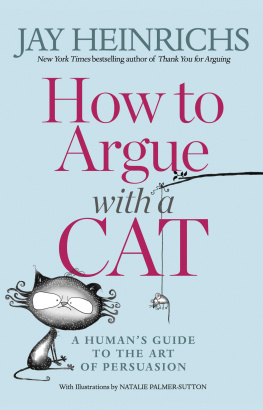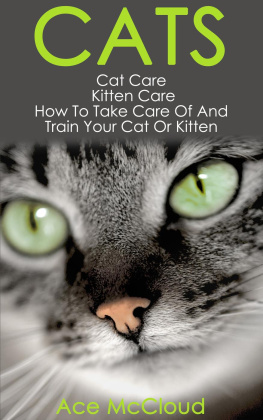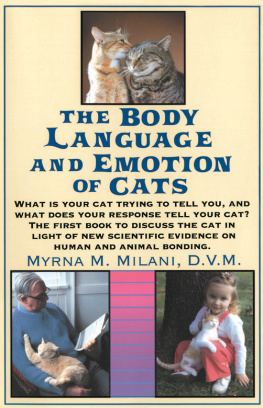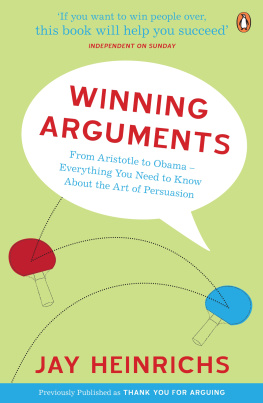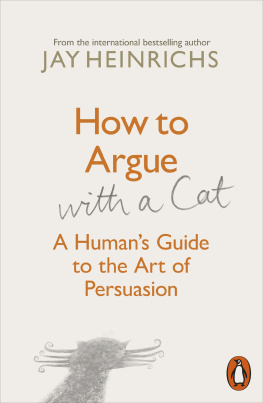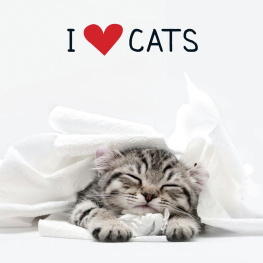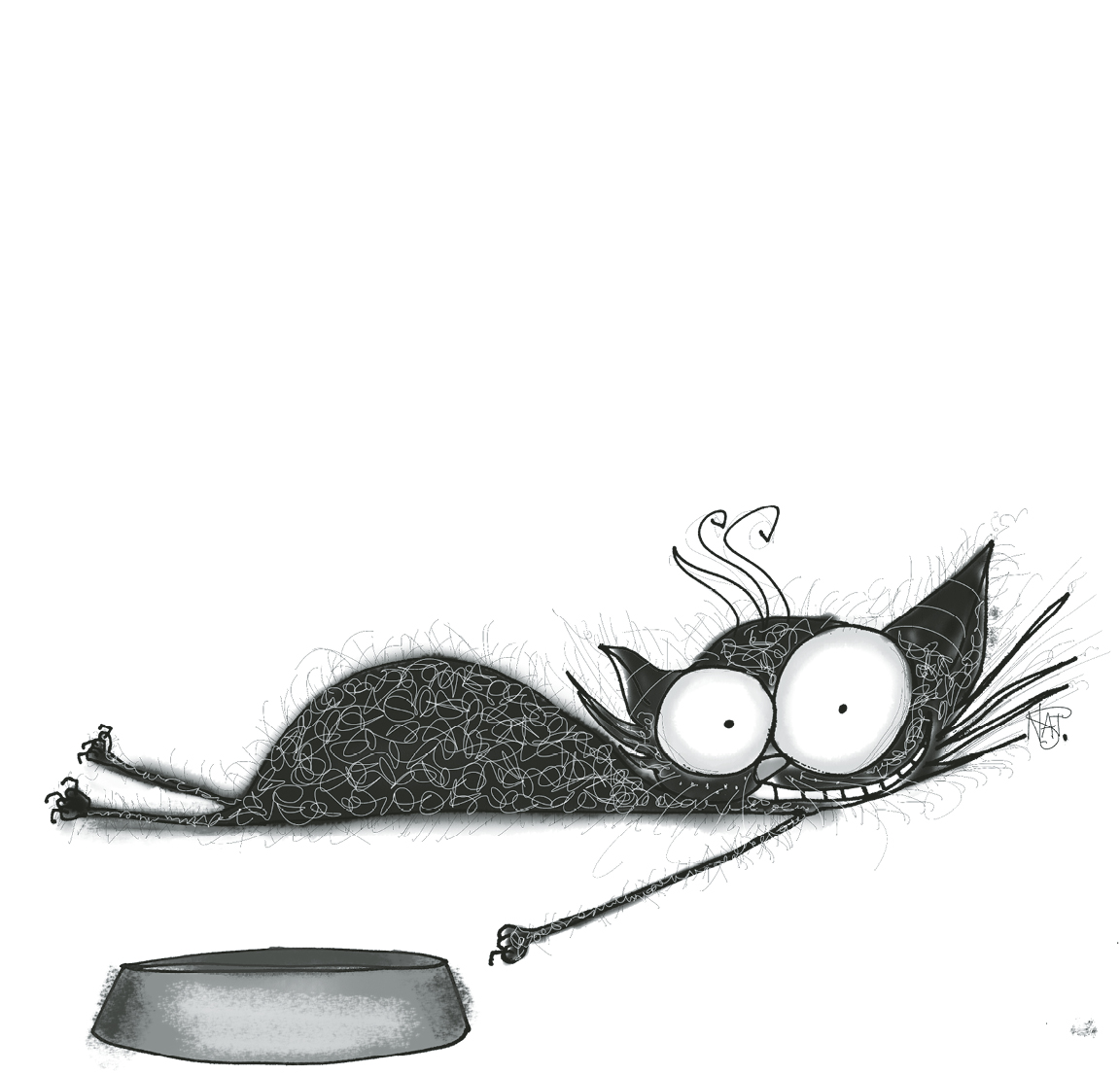Contents
About the Author
Jay Heinrichs is the bestselling author of Thank You for Arguing . He has written for dozens of publications, including The New York Times Magazine , Vice and the Huffington Post , and won numerous journalism awards. He has taught persuasion to editors at Ivy League universities, NASA and the Pentagon. He runs the acclaimed blog Figarospeech.com, as well as the rhetoric site ArgueLab.com.
jayheinrichs.com
Epilogue: Cats of Character
And what theyve taught us
What greater gift than the love of a cat.
Charles Dickens
The cats in our lives have all been great friends and worthy opponents.
Sassy , jet black and decisive, was the alpha male when Jay was growing up. Sassy did not suffer fools. He considered Jay one of them. This cat was the commanding sort of arguer who often got his way through threatshissing and an occasional swipe. Mostly, he was decisive. Knowing what you want is the first rule of persuasion.
Willow , an abandoned kitten, talked Jays little brother into taking her home. Then she used her skills on a reluctant dad. It helped that she was adorable: a perfect light grey, like pussy willow.
Zelmo was a street cat in Washington, DC . He was what the French call a flneur , a man about town. Zelmo assumed everyone loved him, and so they did. We all should be more like Zelmo. Assume you are loved, and most people will love you.
A few days before Christmas, somebody placed Charlie in a box with his brother, Percy. The box got left at a police station. Charlie adopted Natalies 11-year-old daughter, Amelie. He sleeps on a bookshelf in her room and converses loudly with her. Good conversationalists are rare, especially among cats. Amelie writes about Charlie: A playful, curious cat who is hungry for adventure (and mice), he is loving and smart and cute. He is also my alarm clock. He acts as my bodyguard, sitting at the bottom of my stairs. We are so attached to each other and we look after each other. When it comes to food he is very sneaky as you can see his paw gradually getting closer to your plate and then he strikes and misses.
Percy , Charlies brother, adopted Amelies 9-year-old brother, Ben. Well let Ben take over here: Percy is a loving cat who always follows the person he loves the most. He never stops purring. He is loyal and able to find his owner wherever he is. He is very stinky and has a mini beard on his chin. He loves to be cuddled and stroked but if you want to cuddle him, you have to approach him in the right way. This is true of humans as well. Percy died young, which is very sad.
After Percy came Dottie , the worlds most agreeable cat. Knowing that agreeability is the most persuasive attitude of all, Dottie uses her love of everybody to get everything she wants. Whenever Charlie grooms himself, she lies right under his tongue to get a free bath. Whenever Charlie lies down for a nap, she uses him for a pillow. And Charlie never complains, because Dottie is so agreeable. She even practices decorum: With impeccable table manners, she sits quietly until people stop paying her attention. Then she steals their food.
Isabella came along when Jays young daughter began hanging up cat calendars. (You can see more of Isabella in a little book he published on Blurb.com, Sniff It First, & 15 Other Things I Learned From My Cat. ) Isabella was territorial, ill-behaved and rather fat. But she knew how to be funny. With a good sense of slapstick you will go far in this world.
Bat-eared, great-souled Aubrey was born with many physical problems. Though he couldnt walk properly, he gently ruled over his much larger brother, Maturin . Aubrey lived less than two years. But the greatest persuasion is the way you live your life. Aubrey was the best of all persuaders.
Killick was bred as an Italian stud. Though he has been fixed, he still acts like a stud. The world exists to entertain him. This belief makes him an entertaining companion. Great persuaders know that, in order to persuade, they must hold their audiences attention. Give Killick a paper clip or a shoelace (especially one youre attempting to tie) and he will turn it into a circus.
Dorothy Jr and George (daughter and son of Jay) and Amelie and Ben (daughter and son of Natalie) are technically human. But they are all charming and loyal and as hard to persuade as cats. We love them all.
cat wisdom
Small persuasive creatures rule the world.
Practice Agreeability: The Brilliant Purr
Turn a disagreement into a beautiful relationship
To err is human, to purr is feline.
Robert Byrne
The first thing every cat knows, and you should know too, is that an argument is not a fight. In a fight, you try to win . You want to dominate the other person and make him admit defeat. The loser in a fight is never very happy about it.
In an argument, you try to win over the other creature. You get your opponent to agree on a solution, or to make a choice. While both a fight and an argument start with a disagreement, only an argument can make both sides happy. How? By reaching an agreement that benefits both of you. In the best kind of argument, both sides think they won.
A cat knows the difference by instinct. When she sinks her teeth into you, she means to fight. Its a play-fight maybe, but still fighting. She is not interested in a useful conversation. Her goal is to win the fight.
Same thing when a little boy sinks his teeth into his sister. This probably isnt a play-fight. He probably feels angry. Still, his goal is the same as the cats. He wants to beat his sister in a fight.
Most adults dont bite each other. Not much, anyway. Instead, they fight by trying to score points off each other. They often treat a disagreement as a kind of debate. Its as if they think an invisible panel will be holding up score cards at the end, judging who won the most points in the debate.
Or an adult will point out how the disagreement proves what a jerk the other person is. Or shell point out her opponents past idiotic opinions and mistakes. In each case, she is not arguing. Shes fighting. Trying to win. From a persuasion standpoint, her behavior works about as well as biting does, though its maybe a little less painful.
So is there a way to turn a disagreement into something positive? Yes. By arguing. An argument is not about domination. Its about getting another person to make a choice or take an action that you want.
A cat who bites means to fight. But a cat who gently claws your leg is making an argument: Pay me attention. I want food/play/love/access to high places. (Every cat was a monkey in his past life.)
The leg-clawing offers the perfect opening to an intelligent dialogue, where you can share points of view and develop a mutually satisfying conclusion.
Jay: Want to get up on the highest bookshelf? The one you can never get down from?
Killick: [ Claws a little more insistently. ]
Jay: How about my shoulder? [ Picks up the cat. ]
Killick: [ Balances precariously on Jays shoulder, looking meaningfully at the highest shelf. ]
Jay: Tell you what. Well go check the bird feeder out the window and imagine eating the sparrows.
Killick: [ Aims Jay towards the window. ]
This is the perfect argument. Killick enjoys the high vantage point, and Jay has an excuse to skip a chore. An argument starts with a disagreement and ends up with a choice that both sides can live with.
A fight, on the other hand, usually comes with anger. While an argument can also start with somebody getting angry, the whole point is to settle something. To make a mutual choice.

